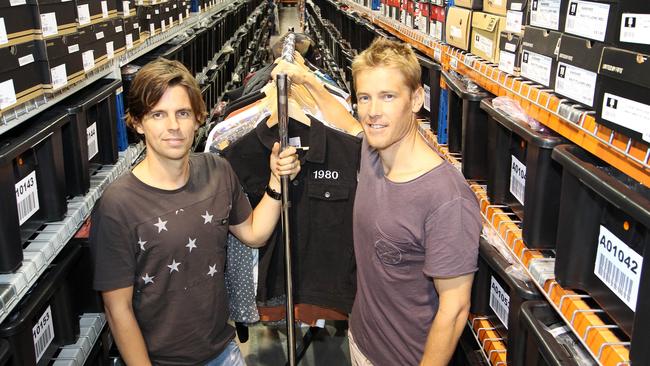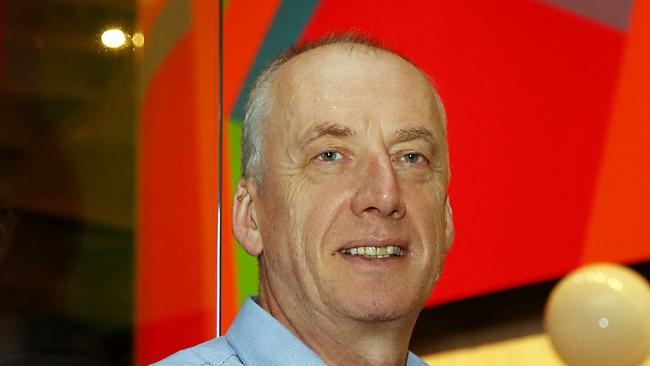Former stockmarket darling SurfStitch has been on a wild ride as shares and profits plunge
IT aimed to be the next global e-commerce surfing sensation. Savvy investors across the globe were captivated by the SurfStitch story.

News
Don't miss out on the headlines from News. Followed categories will be added to My News.
IT aimed to be the next global e-commerce surfing sensation.
Savvy investors across the globe were captivated by the SurfStitch story.
Two surfing mates — Justin Cameron and Lex Pedersen — started out in a garage in Sydney’s northern beaches in 2007.
They sold stuff on eBay and mortgaged themselves to the hilt to build the world’s leading online retailer which was to be the go-to place for everything surfing and action sports related.
In 2009, they were bought out by Billabong but later bought the stake back and the SurfStitch ride started.

The pair set out to not be Billabong, saying the aim was not to grow too fast and lose touch with their core youth customer base.
In 2011, SurfStitch relocated from North Sydney to the home of surfing in Australia, Burleigh Heads, opening an office near big brother Billabong and a warehouse up the road to support its growth ambitions.
The company began picking up awards, including the Best Pure-Play online retailer at the Online Retail Industry Awards and Best Use of Technology award
In 2012, SurfStitch Europe was established with a headquarters in France, including an 8000sq m distribution centre.

By 2013, the company said on its website it had reached 400 brands which quickly grew to 600 of the world’s leading surf, street and fashion brands which, SurfStitch said, cemented it as a world leader in the field of e-commerce.
By 2014, after working their butts off, Cameron and Pedersen incorporated SurfStitch Holdings and raised $65 million from Australian and offshore investors.
The funds enabled the pair to buy back Billabong’s 51 per cent stake and acquire 100 per cent of US-based e-commerce action sports business, SWELL.com.

GOING PUBLIC
On December 16, 2014, the SurfStitch Group listed on the Australian Stock Exchange.
It quickly became a stockmarket darling, recording double-digit revenue growth which sent its shares skywards.
The shares, issued at $1, peaked at a high of $2.13 in November 2015.
SurfStitch grew to have operations in Australia, UK, North America, France and Japan, employing 500 people globally.
Charismatic former investment banker Cameron, who had worked for many of the top players, including Credit Suisse and ABN AMRO, had investors rapt, with analysts awed by his grasp of the numbers.
In November 2015, SurfStitch became bigger than Billabong
SurfStitch was worth $511 million, after raising $50 million to buy Surf Hardware International for $23.7 million) while Billabong’s market value peaked at $510 million.
BIG BUY UP
Then the group grew hungry.
It launched a rapid acquisition spree, spending millions to buy a raft of online surf content platforms, a surf forecasting network and began producing action sports content.
SurfStitch in May 2015 bought Stab, a leading online surf content platform.
It also bought Magicseaweed, a user-generated surf-forecasting network.
It added Garage Entertainment and Production, which makes action sports films and videos.
It acquired The Lens, a content publishing platform created for customers to engage in and experience everything action sports and youth lifestyle related
It also picked up SHI, which makes surfboard fins, plugs, grips, leashes and bodyboards, and owns brands including FCS, Gorilla, Hydro and Softech. That was SurfStitch’s first foray into manufacturing.
The company in 2015 announced plans to open three flagship bricks-and-mortar destination stores under the SWELL brand so consumers could experience first-hand SurfStitch’s brands and content, and those of its suppliers, but, it said, its core business would always be online.
SurfStitch also tapped investors for cash, completing three capital railings.
HITTING A REEF
Then came the downward ride.
Critics say it was the speed of acquisitions, the move away from being a pure-play online action sports retailer and its morphing into a content producer which saw SurfStitch unravel.
Like most retailers, it was hit by tough retail headwinds in its core markets of Australia and North America and admitted it had not been able to integrate its string of acquisitions as quickly as planned.
Alarm bells started ringing in February when the group dumped its full-year earnings forecast, with Cameron instead telling investors the group wanted to invest in growth.
Cameron did not reaffirm SurfStitch’s full-year pre-tax earnings guidance of up to $18 million, which compared with $7.7 million in 2015.
Analysts had forecast $21 million.
In March, Cameron dropped a bombshell.
The former co-founder and CEO said, by email, he was resigning.
It emerged he was planning a buyout of the company with a private equity group.
Apparently the deal was just a handshake agreement, the private equity player walked away and, despite reports he has approached the board, nothing has been heard from Cameron since.
No private equity punter has approached the ailing SurfStitch to talk about a takeover.
The euphoria finally died last month after SurfStitch unveiled a heavily watered-down profit warning, slashing forecast pre-tax full-year earnings from $18 million to between $2 million to $3 million.
Its shares nosedived by up to 60 per cent to close at 48¢.
IS THIS THE END?
Last week, SurfStitch saw $500 million wiped from its market value after it hit another massive glitch, issuing its third profit downgrade this year.
It now expects to post a pre-tax full-year $18 million loss due to the unravelling of a licensing deal which cost it around $20 million in lost revenue.
SurfStitch also appointed a new CEO, retail veteran Mike Sonand, who has admitted he has his work cut out in saving the group because the company’s management took its eye off the ball.
Its shares were battered, slumping to a low of 25¢.
IG market strategist Evan Lucas said SurfStitch had been caught up in “not being Billabong”.
He said it appeared the company had reached “crisis point” between being a start-up and reaching maturity. Mr Lucas believes “going private” may be the only way to save SurfStitch.
At the weekend came another blow.
National law firm Gadens said it is planning a $500 million class action against SurfStitch, alleging it failed to keep the market informed about its true financial position.
Glenn McGowan QC, who is leading the potential class action, said he has been deluged with calls from irate mum and dad investors, most from Queensland, some of whom have lost their life savings after investing in SurfStitch.
Even Mr McGowan, who says any potential claim may exceed $500 million, says he doesn’t want SurfStitch to go under but just wants “to keep management on their toes”.


